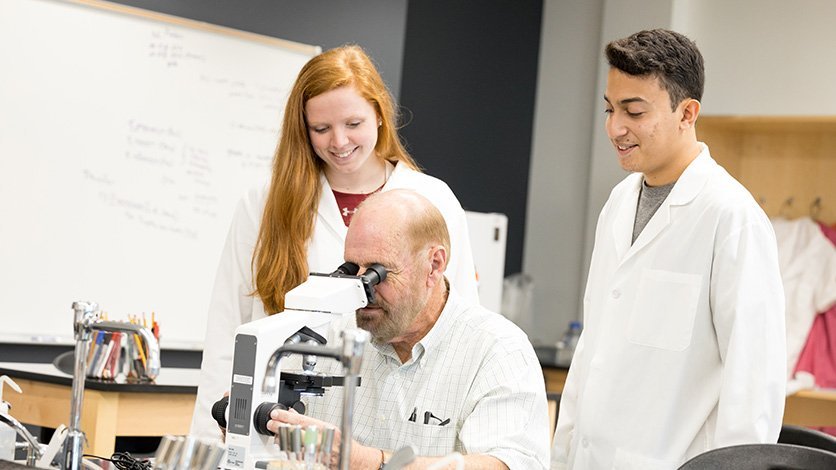
Microbiology Research Beyond the Lab
Solving Problems in the Modern World

Since the mid-1970s, when the biology faculty established BIO 400 — aka Research Problems — Lenoir-Rhyne biology majors have used the course as a platform to tackle complex challenges in their own way.
“They decided on one semester, which is an ambitious timeline, but it’s enough to narrow a focus, develop a hypothesis, conduct experiments, then write and present a paper with the findings. It gives everyone a good foundation in research,” said biology professor Daniel Grimm, Ph.D., who now joins two of the program’s founding professors — Marsha Fanning, Ph.D., and Dale Burnside, Ph.D. — in supervising research.
Later, the program added a multi-semester research option, and some students opt to extend their research even further. Students work closely with professors whose specialty aligns with their proposed research, so Grimm advises students researching topics in microbiology.
Professor Grimm's passion for science is only rivaled by his enthusiasm for helping students succeed.
Recent research topics — plastic pollution, climate change, antibiotic resistance, alternative medicine — would have been difficult to predict at the program’s inception, but that flexibility has preserved its relevance and value for generations.
“The beauty and genius of this model is that the students get to choose the project area of research they’re interested in and take the lead in asking questions,” Grimm shared.
Are bacteria the answer to plastic overload?
Diego Sanjuan ’24 found a research focus with global impact while ordering lunch on campus.

“It started — as great science research often does — waiting in line for a sandwich at Chick-fil-A,” Sanjuan recalled. “I noticed that one of the workers was wearing gloves for sanitation, and every time she handled a new order, she had to take off the gloves and replace them.”
A 2020 United Nations study estimated world plastic production at 400 million metric tons per year. Most of that plastic isn’t recycled, and a large percentage of it ends up in the oceans, where it damages the ecosystem and food supply.
“The specific statistics didn’t stick with me so much as just how large the numbers were. There’s this almost incomprehensible amount of plastic waste out there — and what do we do about it?” Sanjuan shared.
As a biochemistry major, he looked at the possibility that some organisms have adapted to take advantage of such a plentiful food source.
“One of the first articles I read was about Ideonella sakaiensis, which researchers found in a puddle outside a waste treatment plant in Japan in 2016, consuming polyethylene terephthalate or PET — it’s used in plastic water bottles.”
Ideonella sakaiensis is one of a few microbes that have adapted to consume plastics, but their use in waste management is not assured.
“People read about a bacterium discovered in Japan, and they think it’s going to revolutionize the recycling industry overnight, but that’s not how it happens,” Sanjuan said.
Instead, scientists around the world contribute to a growing body of research to determine how — or even if — these plastic-eating organisms can help make a dent in all those tons of plastic. Working with Grimm and with chemistry professor Joshua Ring, Ph.D., Sanjuan’s study will join that body of research as he studies certain waxworms and their ability to degrade low density polyethylene plastic.
“The first step is to determine if the waxworms will eat plastic in the lab, then we have to extract and grow the internal bacteria that allows the worms to digest plastic,” Sanjuan said.
It’s validating to me as a scientist to know I’m capable of conducting this research and contributing to an established community.
The steps that follow involve developing and testing a method to contain large numbers of these bacteria while they continue to produce digestive enzymes. “A good analogy is a hamster on a wheel — in one place, but it keeps going as long as it has an incentive,” Sanjuan explained.
If this method works, more research would determine if it’s possible on an industrial scale without creating other issues, such as excess carbon dioxide production from the bacteria themselves or microplastics in the environment.
“Even if all this works, we’re looking at a trade-off, not a miracle, to minimize something large to a more manageable scale,” Sanjuan shared. “It’s validating to me as a scientist to know I’m capable of conducting this research and contributing to an established community.”
Can essential oils fight ear infections?
Ear infections — or otitis media — are among the most common and painful childhood ailments, as pre-medical science major Colette Romp ’23 learned firsthand.
“I nanny for three boys during the summer, and I remember the youngest one had two or three ear infections in one summer. He was so miserable,” Romp shared.
Antibiotics cleared up the infections for Romp’s young charge, but her studies have made her all too aware of the ramifications of such frequent administration of antibiotics.
“Antibiotics still work for otitis media, but between providers prescribing a lot of general antibiotics and patients not finishing the full prescribed course, the bacteria that cause earaches are slowly developing resistance,” Romp explained.
The use of essential oils has become trendy as a home remedy in recent years, and many of those oils have antimicrobial properties. Romp wondered if those properties could be harnessed as focused treatments for ailments such as otitis media.
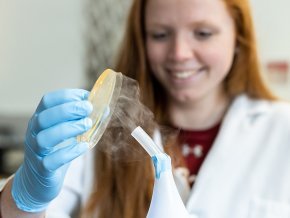
“I have friends that love essential oils. If they have a cough, they put peppermint oil on their chest, and they swear by it,” Romp shared. “But my science mind wants to investigate — are these remedies really helping or do they just feel like they’re helping?”
Essential oils have been the focus of numerous studies investigating their properties as well as the benefits and drawbacks of their use.
“There are a lot of articles and studies about using essential oils as a potential treatment for respiratory infections, but not much on their use with ear infections. That’s what I’m looking into,” Romp explained.
Romp hopes to determine if delivery of these oils via a vapor across the tympanic membrane can kill bacteria as a potential treatment for ear infections.
“A lot of my experiment is method development because no one has done this before, to my knowledge,” Romp shared. “I have one semester, and my method might not work, but rejecting a hypothesis is important because it rules out a possibility and gets you a step closer to supporting the hypothesis.”
Can multidrug-resistant “superbugs” become less super?
While alternative treatments might delay bacteria developing resistance to antibiotics, Sydney Karre ’20 wondered what recourse we have once a microbe does develop resistance. Commonly known as “superbugs,” these organisms can cause devastating damage in little time.

“Multidrug-resistant bacteria pose a real danger — especially in hospital settings — because if you can’t slow down or kill the bacteria, people can die from the infection,” said Karre, whose honors research spanned four semesters.
“Before antibiotics were discovered, physicians used bacteriophages, which are naturally occurring viruses in nature that kill bacteria. I wanted to see how these bacteriophages could be used against superbugs.”
Each bacteriophage is specific to the bacterium it attacks, so they don’t produce the side effects common with antibiotics. However, bacteriophages live where bacteria are plentiful, making isolating them for research a unique challenge.
Everywhere I applied, they were blown away by how impressive my undergraduate research was.
“I collected lake water and ocean water, soil samples and even some raw sewage from the water treatment plant so Dr. Grimm and I could isolate these bacteriophages,” Karre shared.
Karre and Grimm then adapted a method to purify the phages from the source and match them to target strains of bacteria.
“After we purified the bacteriophage, we’d treat the multidrug-resistant bacteria it was sensitive to. Just like with antibiotics, you won’t kill everything with the first dose, so the second stage addressed the bacteria that survived the first attack,” said Karre.
Instead of treating the surviving superbugs with a second round of phages, she tested their sensitivity to antibiotics.

“I hypothesized that the bacteriophage attack would change the bacteria’s susceptibility to antibiotic treatment, and in all our studies, that’s what happened,” Karre shared.
Karre presented her findings at a few conferences with a recommendation for further research into the potential for tandem use of phages and antibiotics to treat multidrug-resistant infections in hospitals.
“When I came to LR, I worried about getting the kind of research experience I would need to be competitive in applying to med school,” she shared. “Instead, everywhere I applied, they were blown away by how impressive my undergraduate research was. I applied to 14 programs and got 10 interview offers. I went to five of those interviews and was accepted to all five schools.”
Now working on her MD at Wake Forest University, she has found her undergraduate research has prepared her for the intellectual rigor and problem-solving her field requires.
“I plan to go into clinical practice, but it’s very common for MDs to do research as well, so I’m hoping to start some research this summer — possibly with the CDC or here at Wake Forest in pediatric intensive care or anesthesiology,” Karre shared.
While she explores her future research options, she has discovered her past research keeps yielding benefits.
“Reaching out to professors and researchers, they always want to see a writing sample, so I send a copy of my thesis. They can’t believe it’s an undergrad project, so it’s still opening doors for me. I have a lot of options, and I feel blessed for that.”
How does Alzheimer’s disease develop in brain tissue?
Statistics projecting a substantial increase in Alzheimer’s patients in the coming decades — from around 6 million current cases to 13 million by 2050 — inspired John Amodeo ’18 to turn his interest in biochemistry and human health toward researching this disease.
“The idea was because people are living longer, we’re seeing more of these age-related diseases. I saw an opportunity to study some interesting phenomena at the molecular level in a way that would be meaningful and offer some insight for ways people can stay healthy,” he shared.
Alzheimer’s disease results from the buildup of protein pieces called beta-amyloids into clumps or plaques in the brain’s neural tissue. Research has shown a correlation between exposure to reactive oxygen species — unstable molecules that react easily with molecules in a cell — and the development of these plaques.
“There was a lot of research discussing this link, but none of the papers I read made it clear how it was happening at the fundamental level,” Amodeo explained.
“I designed an experiment exposing amyloid-beta proteins to hydrogen peroxide to measure the rates of folding and accumulation of plaques at increasing concentrations of peroxide.”
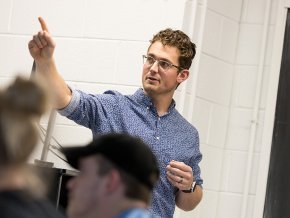
The study won an award at the North Carolina Academy of Science Conference and sparked Amodeo’s interest in neuroscience, setting him on the path to pursue a Ph.D. in neurobiology at Duke University.
“When I came to LR, I joined the football team and ran track. I was more interested in sports than academics, but in the liberal arts curriculum, I had an opportunity to sample a lot of different ideas and become a well-rounded thinker. I found my path and showed what I could do academically.”
Designing, conducting and presenting original research in his final semester at LR gave Amodeo a preview of his academic future. While he has moved away from molecular analysis, his passion for neuroscience and his determination to solve difficult problems remains. Currently, that problem involves looking at the brain’s chemical and electrical reactions associated with attention.
In a lot of places, undergrads are assigned to someone else’s larger project and get a small piece of that. The choice and control our students have is somewhat unique to LR.
“When you get to grad school, you’re at the frontier of knowledge, so you have to learn to forge into the unknown and understand whatever it is you’re pursuing. You get better at the process the more you do it, but my undergrad thesis gave me the tools to start developing the skills I use every day.”
For the future of students and science
Karre and Amodeo are among many biology graduates whose research opened the paths of interest and opportunity to the next level of their academic careers.
“Our students find when they go to interviews for graduate schools, med schools or jobs, their interviewers are really interested in their research. In a lot of places, undergrads are assigned to someone else’s larger project and get a small piece of that,” Grimm explained. “The choice and control our students have is somewhat unique to LR.”
With the support and resources of the biology department, the experience is valuable whether or not students confirm their hypotheses.
Grimm shared, “I like when a student will go way out on a limb and do something that may not work. That’s how research works.”
Sanjuan has taken in this message about the nature of science, however his own research turns out in the end. “You’re adding a teacup — a teaspoon — to the other teacups and teaspoons of research out there, and when all those spoons combine, they can fill an ocean."
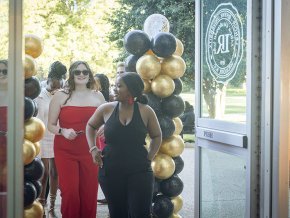
The revamped 2024 Student Life Awards gave students "A Night to Remember" with recognition and celebration of the joys of being a Bear.
View More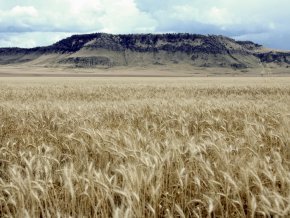
Susan McArver, Ph.D., took a deep dive into the role of the church behind the history of colonization and domination over Indigenous peoples in the Americas during her fall Explore Course, “The Land and its Inhabitants.”
View More